1. Refer to the exhibit. A network administrator wants to verify the proper operations of the HSRP. On the basis of the outputs provided, which routers are in the active and the standby roles for the HSRP group 10?
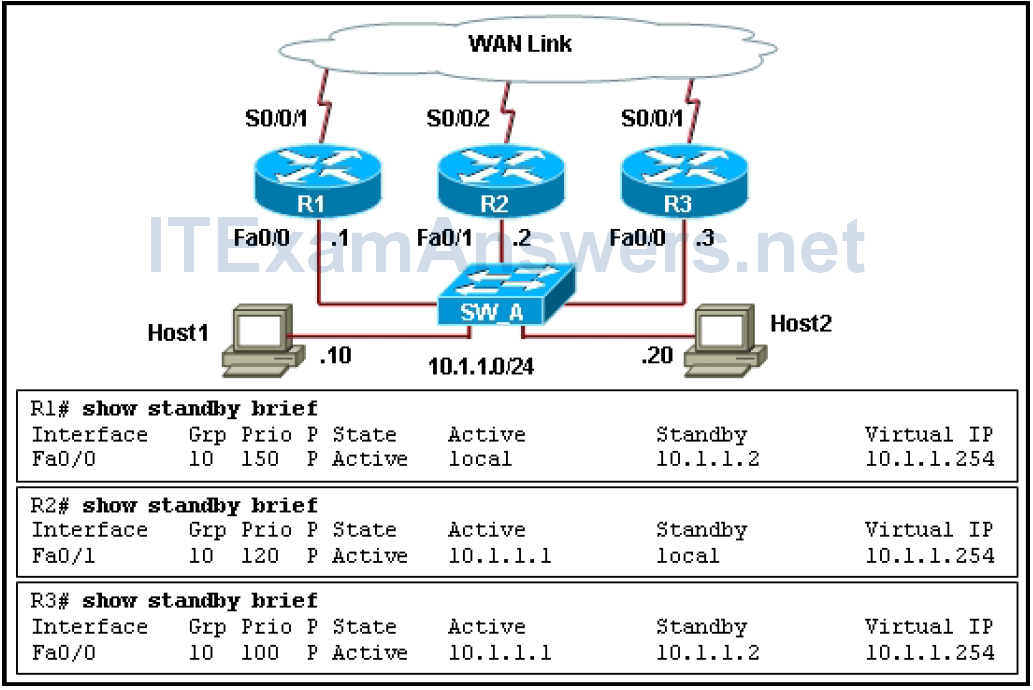
- Router R2 will be the active and router R3 will be the standby.
- Router R3 will be the active and router R1 will be the standby.
- Router R1 will be the active and router R3 will be the standby.
- Router R1 will be the active and router R2 will be the standby.*
2. Refer to the exhibit. Router R1 was recently included in HSRP group 1. On the basis of the debug standby terse output that is provided, which statement is true?
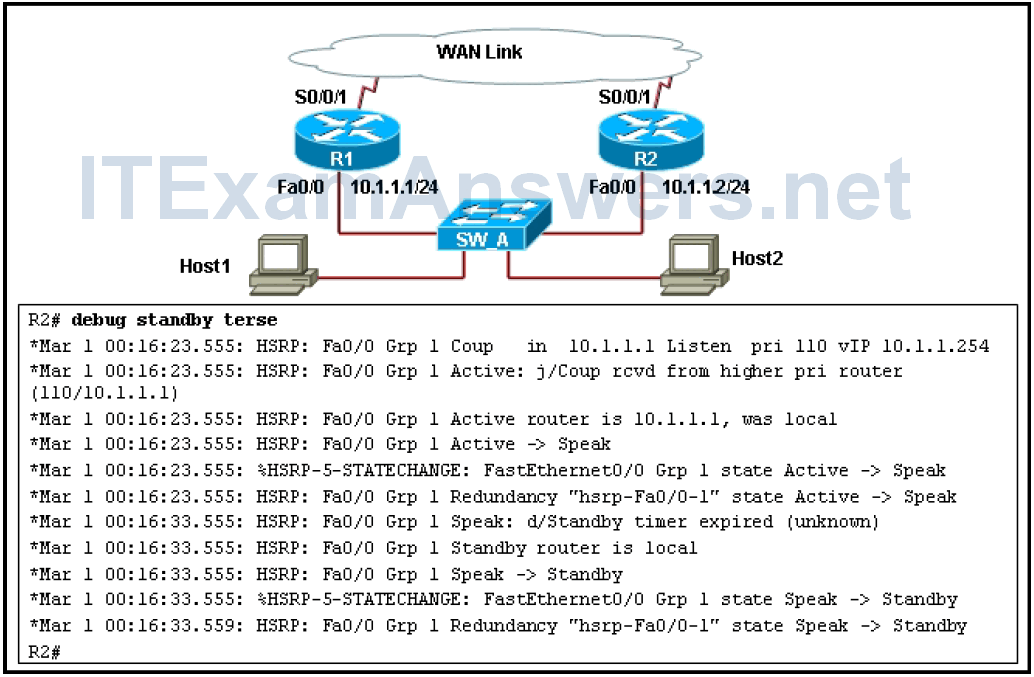
- R2 will keep the active role, and R1 will become a standby router.
- R2 promoted itself to the active role when its holddown timer expired before it saw a better candidate for the role of active router.
- R1 has promoted itself to the role of active router and R2 has assumed the role of standby router.*
- R1 and R2 will alternate between the active and the standby role because of a conflict in the HSRP priority that is configured on the routers.
3. Which two port configurations will prevent EtherChannel from forming between two Cisco switches? (Choose two.)
- Both of the ports are configured as trunks.
- The ports have different STP port costs.
- One of the ports has port security enabled.*
- The native VLAN is not the same on both ports.*
4. Refer to the exhibit. A network administrator is troubleshooting an HSRP related problem and confirms that router R1 is the active HSRP router. Which command could be issued on a Windows host to verify the virtual IP and MAC address are the same as configured on R1?
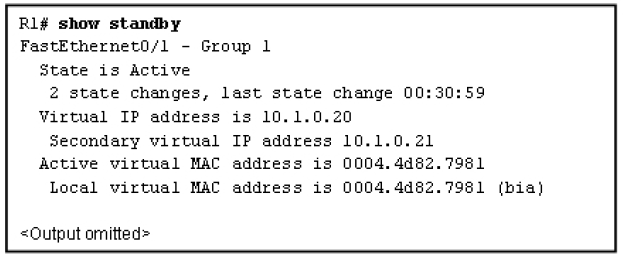
- C:\> netstat
- C:\> tracert virtualip
- C:\> ipconfig /renew
- C:\> ping virtualip
- C:\> arp a *
5. Which IETF solution should be used to provide first hop redundancy in a multivendor network environment?
- Cisco Express Forwarding (CEF)
- Gateway Load Balancing Protocol (GLBP)
- switch virtual interface (SVI)
- Forwarding Information Base (FIB)
- Virtual Router Redundancy Protocol (VRRP) *
- Hot Standby Router Protocol (HSRP)
6. Refer to the exhibit. Based on the information that is presented in the exhibit, which statement is true?

- Router R1 is currently the standby router.
- The Virtual Router Redundancy Protocol (VRRP) has been configured.
- The reachable IP address of the standby router is 10.1.1.2. *
- The IP address 10.1.1.254 is a loopback address on router R1.
- Router R1 is using the default priority value.
- The Gateway Load Balancing Protocol (GLBP) has been configured.
7. A network administrator created an EtherChannel that consists of four physical links. Upon examination of the log files, the administrator observed the following message.
Nov 30 15:05:45: %EC5CANNOT_BUNDLE2: Gi1/1 is not compatible with Gi1/2 and will be suspended
What is the cause of this error message?
- Only one switch is properly configured for EtherChannel.
- The switch has suspended a physical link because of incompatibilities.*
- The switch was not able to create the EtherChannel link.
- There is an uneven distribution of traffic on the EtherChannel bundle members.
- The Link Aggregation Control Protocol (LACP) is incompatible with the version of the IOS that is running on the switch.
8. Refer to the exhibit. What is the meaning of the uppercase letter “S” beside the Po10 interface?

- Po10 has been suspended.
- Po10 is in symmetrical processing mode.
- Po10 is configured as a Layer 2 interface.*
- Po10 is currently in startup mode.
- Po10 has been configured as a summary interface.
9. Refer to the exhibit. Mutual redistribution has been configured on router R7 between the OSPF and EIGRP routing processes. What could be the reason that EIGRP routes are not being properly redistributed into the OSPF process?
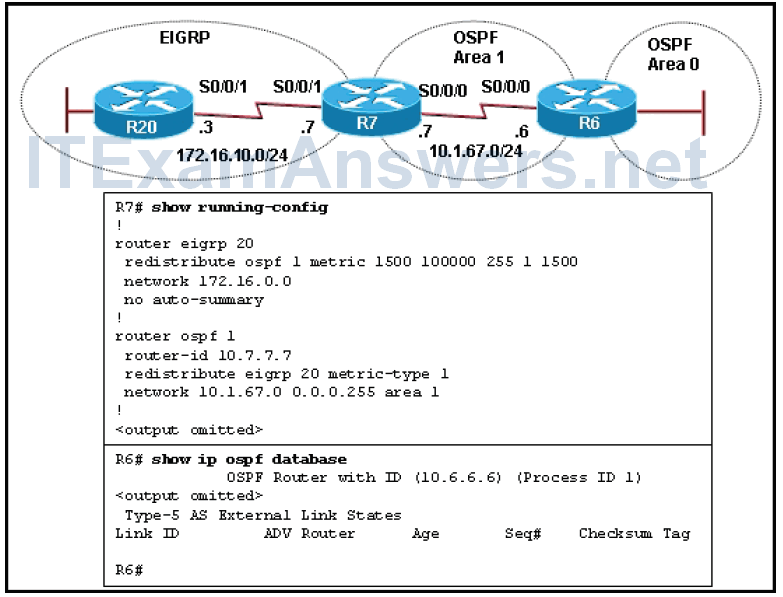
- The OSPF metric configuration is missing for the EIGRP routes that are redistributed into OSPF.
- There is an incorrect external route type configuration for the EIGRP routes that are redistributed into OSPF.
- There is an incorrect EIGRP metric configuration for the OSPF routes that are redistributed into EIGRP.
- The subnets keyword configuration is missing for the EIGRP routes that are redistributed into OSPF.*
10. Refer to the exhibit. Router RTA and router RTB have been configured to exchange routing information using OSPF. However, both routers never transition beyond 2WAY state. What is the cause of this problem?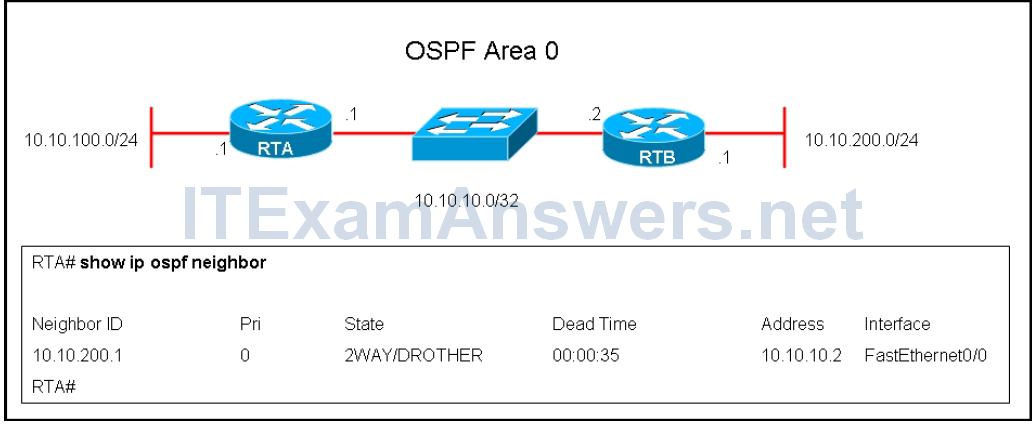
- There is a switch problem and multicast capabilities are broken.
- An access list on one side is blocking OSPF Hellos.
- A priority of 0 has been configured on RTA and RTB interfaces.*
- There is a misconfigured neighbor statement on RTA or RTB.
- Authentication is enabled on only one side.
11. What issue can cause OSPF routers to become stuck in INIT state?
- The OSPF timers do not match.
- The DR cannot be determined.
- Hello packets have not been received by the neighboring routers.*
- A routing loop has been discovered.
12. Which transport layer port is used in BGP peering?
- TCP port 289
- UDP port 179
- TCP port 179 *
- UDP port 289
13. Which OSPF data structure is populated with information that is created by the SPF algorithm?
- interface table
- Routing Information Base *
- linkstate
- database
- neighbor table
14. Refer to the exhibit. A network administrator is unable to have two BGP peers exchange routing information. Which solution would correct this problem?
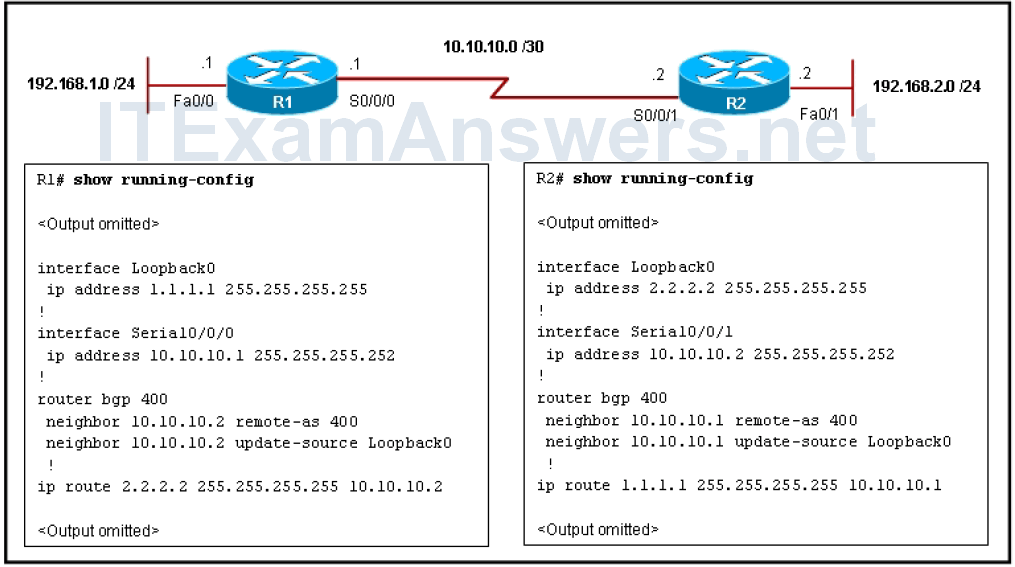
- Enter the neighbor x.x.x.x ebgpmultihop 1 command on R1 and R2.
- Change the neighbor x.x.x.x updatesource command on R1 and R2 to refer to the FastEthernet interfaces.
- Change the neighbor BGP peer IP addresses on R1 and R2 to use the FastEthernet IP addresses of their peers.
- Remove the neighbor x.x.x.x updatesource command from the configurations on R1 and R2.*
15. Refer to the exhibit. A network administrator is unable to have two BGP peers exchange routing information. Which solution would correct this problem?
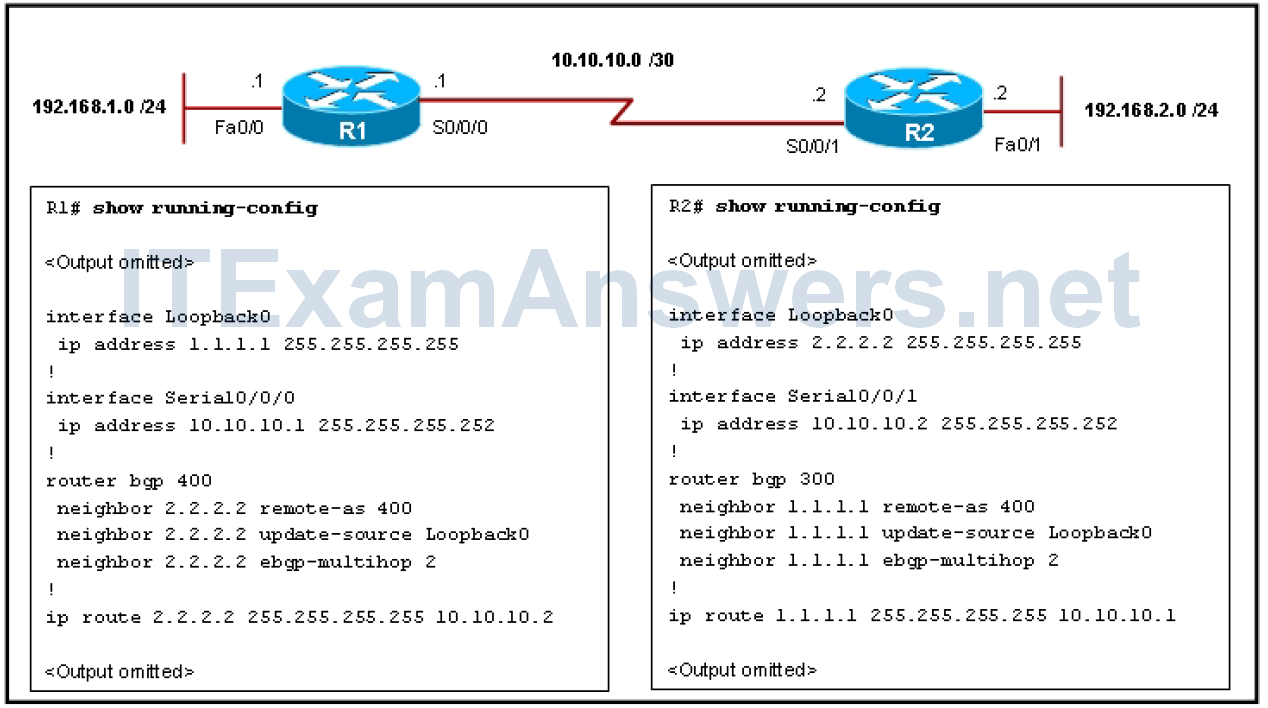
- Router R1 should be configured with the neighbor 2.2.2.2 remoteas 300 command.*
- Router R1 should be configured with the neighbor 2.2.2.2 ebgpmultihop 3 command and R2 with the neighbor 1.1.1.1 ebgpmultihop 3 command.
- The loopback interfaces on each router should be removed.
- Router R1 should be configured with the neighbor 2.2.2.2 ebgpmultihop 1 command and R2 with the neighbor 1.1.1.1 ebgpmultihop 1 command.
16. Refer to the exhibit. Which two statements are true about DHCP snooping on Switch2? (Choose two.)
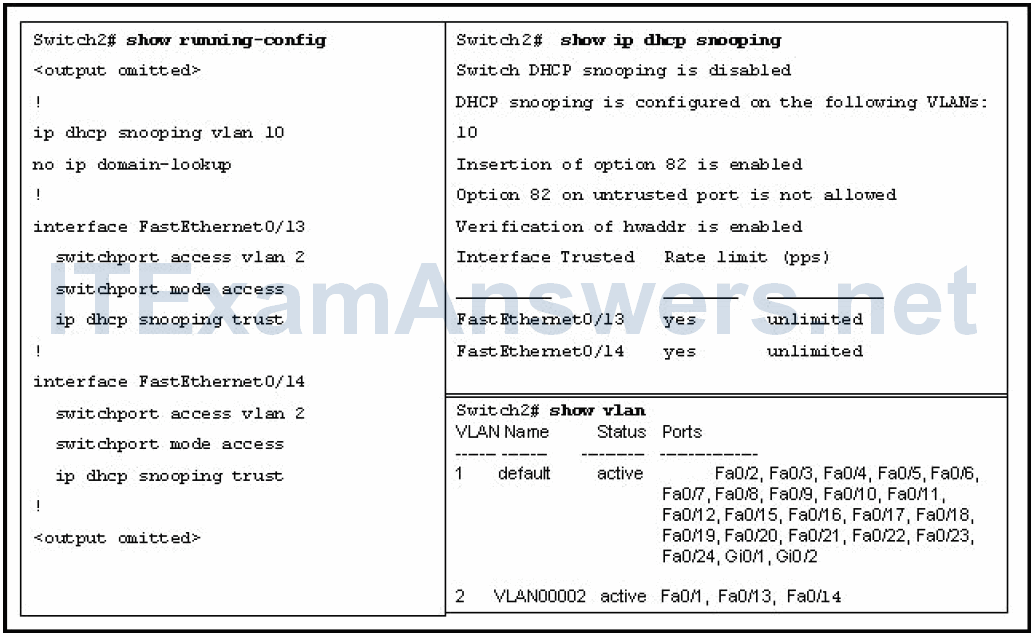
- Any interface assigned to VLAN 10 could host a DHCP server.
- DHCP snooping is configured for VLAN 2.
- DHCP snooping is configured for VLAN 10.*
- DHCP snooping is enabled for interface FastEthernet0/13 and interface FastEthernet0/14.
- DHCP snooping is not enabled for interface FastEthernet0/15 and interface FastEthernet0/16.*
17. Refer to the exhibit. In the show ip route output, what is the source of the 72.163.4.0 /24 route?
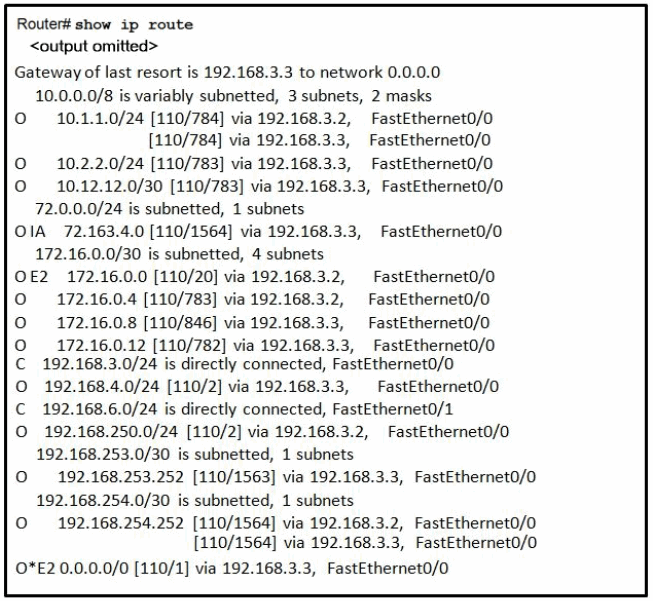
- It comes from a normal area router.
- It comes from a stub area router.
- It comes from an autonomous system border router (ASBR).
- It comes from an area border router (ABR).*
18. Refer to the exhibit. What is a possible reason that Router2 is not receiving OSPF routing updates on interface FastEthernet0/1?
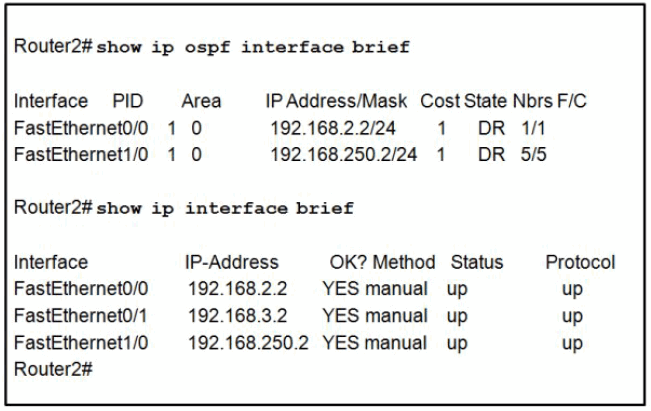
- There is no OSPF network statement for the network to which interface FastEthernet0/1 belongs.*
- Interface FastEthernet0/1 is configured as passive for OSPF.
- The OSPF priority of interface FastEthernet0/1 is set to zero.
- OSPF is not enabled on the neighboring router that is connected to FastEthernet0/1.
19. Refer to the exhibit. A network administrator configured routers R1 and R2 as part of HSRP group 1. After the routers have been reloaded, a user on Host1 complained of lack of connectivity to the Internet The network administrator issued the show standby brief command on both routers to verify the HSRP operations. In addition, the administrator observed the ARP table on Host1. Which entry should be seen in the ARP table on Host1 in order to gain connectivity to the Internet?
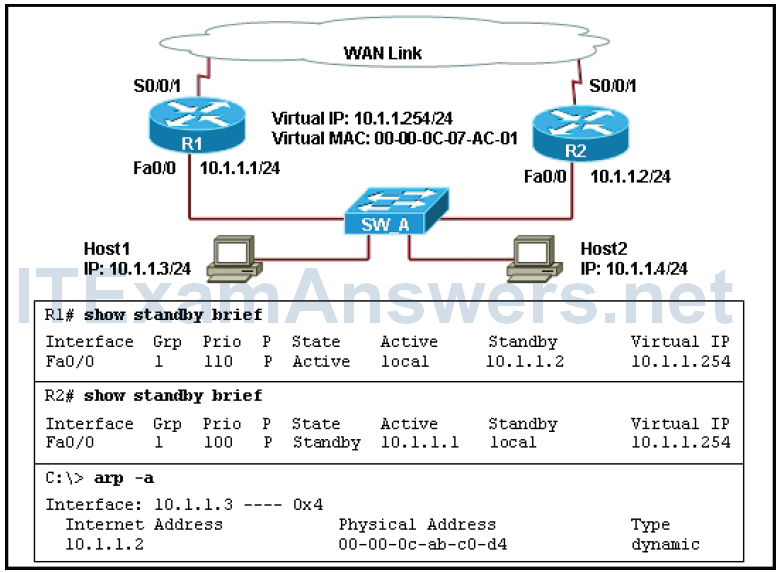
- the virtual IP address of the HSRP group 1 and the MAC address of R1
- the virtual IP address of the HSRP group 1 and the MAC address of R2
- the virtual IP address and the virtual MAC address for the HSRP group 1 *
- the IP address and the MAC address of R1
20. Which two features should be enabled to secure DHCP and ARP? (Choose two.)
- IP Source Guard
- BPDU Filtering
- Dynamic ARP Inspection *
- Private VLANs
- BPDU Guard
- DHCP Snooping *
21. Refer to the exhibit. An administrator is troubleshooting an HSRP implementation on routers R1 and R2. Based on the output in the exhibit, what is the probable cause of the problem?
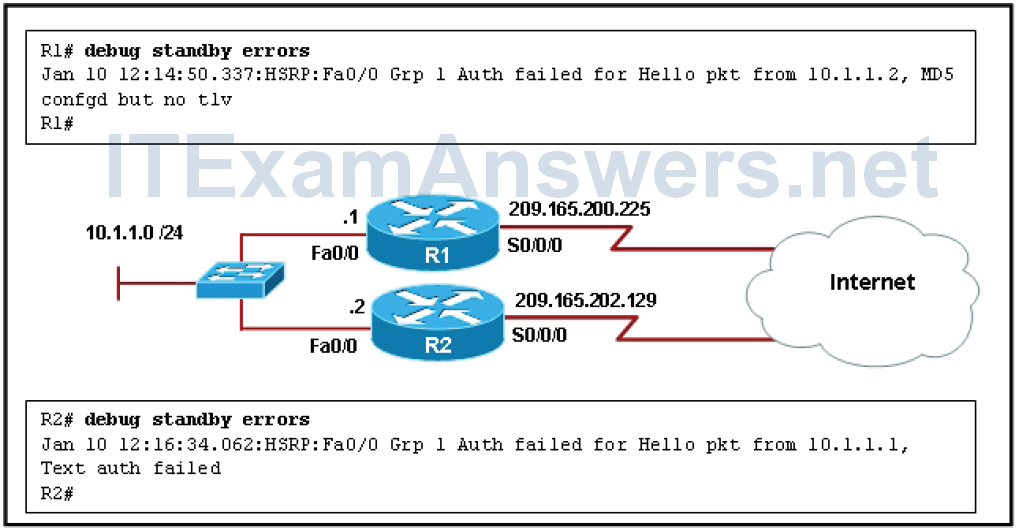
- Routers R1 and R2 have different text authentication strings configured.
- Routers R1 and R2 have different MD5 authentication strings configured.
- Router R1 is configured to support MD5 authentication while router R2 is configured to support text authentication.*
- Router R1 is configured to support text authentication while router R2 is configured to support MD5 authentication.
- Router R2 requires the standby 1 ip 10.1.1.254 command to be issued on interface FastEthernet 0/0.
- Router R1 requires the standby 1 ip 10.1.1.254 command to be issued on interface FastEthernet 0/0.
22. A network administrator is adding a new router into an existing OSPF network and notices that the router is stuck in the INIT state. What is a possible cause of this problem?
- Duplicate Router IDs are configured on the new router.
- An access list is blocking OSPF hellos.*
- There is a mismatched interface MTU.
- Layer 2 switches between the two routers are not multicast aware.
23. Refer to the exhibit. A network administrator decided to include R3, a new router, as part of the already converged HSRP group. On the basis of the configuration that is provided, which router will assume the active role and which router will become standby for the HSRP group 1 when R3 becomes operational?
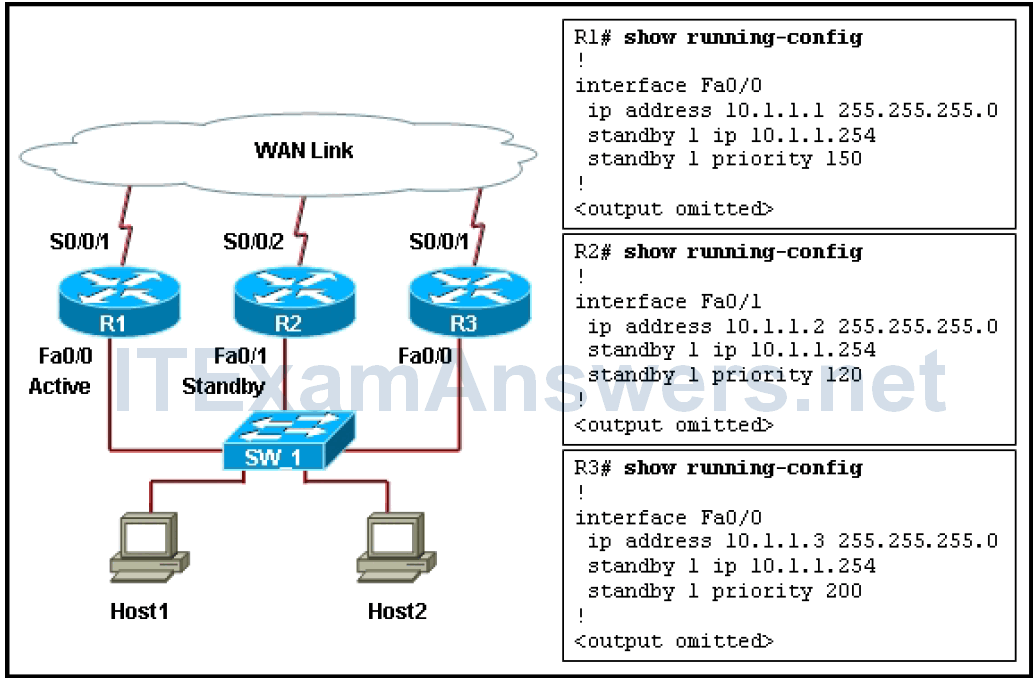
- Router R2 will become active only if router R1 fails.
- Router R1 will keep the active role, and R3 will assume the standby role.*
- Router R3 will become active, and router R1 will assume the standby role.
- Routers R1 and R2 will keep the active and the standby roles.
24. Refer to the exhibit. A network administrator configured routers R1 and R2 as part of HSRP group 1. After the routers have been reloaded, a user on Host1 complained of lack of connectivity to the Internet The network administrator issued the show standby brief command on both routers to verify the HSRP operations. In addition, the administrator observed the ARP table on Host1. Which entry should be seen in the ARP table on Host1 in order to gain connectivity to the Internet?
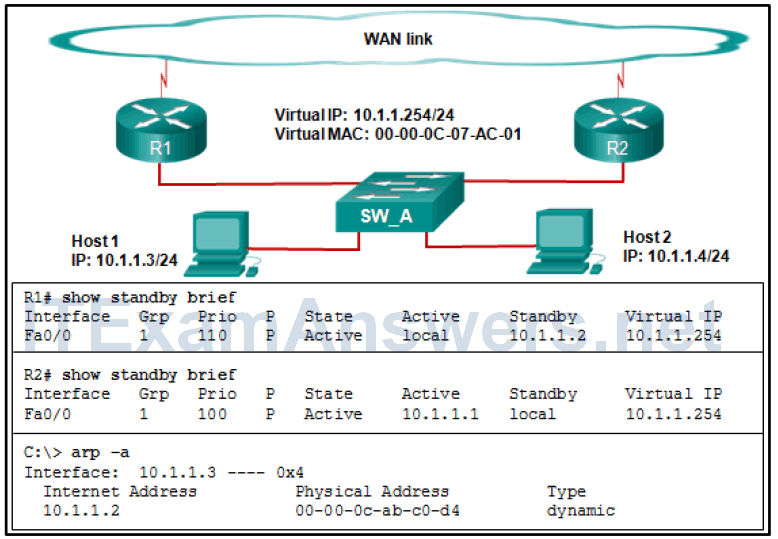
- the virtual IP address of the HSRP group 1 and the MAC address of R1
- the IP address and the MAC address of R1
- the virtual IP address of the HSRP group 1 and the MAC address of R2
- the virtual IP address and the virtual MAC address for the HSRP group 1 *
Download PDF File below:
